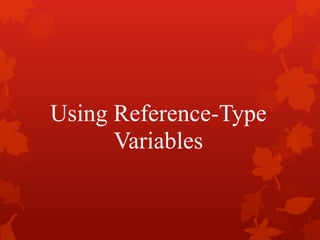
Module 9 : using reference type variables
- 2. Overview Using Reference-Type Variables Using Common Reference Types The Object Hierarchy Namespaces in the .NET Framework Data Conversions
- 3. Using Reference-Type Variables Comparing Value Types to Reference Types Declaring and Releasing Reference Variables Invalid References Comparing Values and Comparing References Multiple References to the Same Object Using References as Method Parameters
- 4. Comparing Value Types to Reference Types Value types The variable contains the value directly Examples: char, int 42 int mol; mol = 42; • string mol; mol = "Hello"; Hello Reference types The variable contains a reference to the data Data is stored in a separate memory area
- 5. Declaring and Releasing Reference Variables Declaring reference variables coordinate c1; c1 = new coordinate(); c1.x = 6.12; c1.y = 4.2; • 6.12 4.2 c1 = null; • 6.12 4.2 Releasing reference variables
- 6. Invalid References If you have invalid references You cannot access members or variables Invalid references at compile time Compiler detects use of uninitialized references Invalid references at run time System will generate an exception error
- 7. Comparing Values and Comparing References Comparing value types == and != compare values Comparing reference types == and != compare the references, not the values • 1.0 2.0 • 1.0 2.0 Different
- 8. Multiple References to the Same Object Two references can refer to the same object Two ways to access the same object for read/write coordinate c1= new coordinate( ); coordinate c2; c1.x = 2.3; c1.y = 7.6; c2 = c1; Console.WriteLine(c1.x + " , " + c1.y); Console.WriteLine(c2.x + " , " + c2.y); • 2.3 7.6 • c1 c2
- 9. Using References as Method Parameters References can be used as parameters When passed by value, data being referenced may be changed static void PassCoordinateByValue(coordinate c) { c.x++; c.y++; } loc.x = 2; loc.y = 3; PassCoordinateByValue(loc); Console.WriteLine(loc.x + " , " + loc.y); 2 3 3 4 • •
- 10. Using Common Reference Types Exception Class String Class Common String Methods, Operators, and Properties String Comparisons String Comparison Operators
- 11. Exception Class Exception is a class Exception objects are used to raise exceptions Create an Exception object by using new Throw the object by using throw Exception types are subclasses of Exception
- 12. String Class Multiple character Unicode data Shorthand for System.String Immutable string s = "Hello"; s[0] = 'c'; // Compile-time error
- 13. Common String Methods, Operators, and Properties Brackets Insert method Length property Copy method Concat method Trim method ToUpper and ToLower methods
- 14. String Comparisons Equals method Value comparison Compare method More comparisons Case-insensitive option Dictionary ordering Locale-specific compare options
- 15. String Comparison Operators The == and != operators are overloaded for strings They are equivalent to String.Equals and !String.Equals string a = "Test"; string b = "Test"; if (a == b) ... // Returns true
- 16. The Object Hierarchy The object Type Common Methods Reflection
- 17. The object Type Synonym for System.Object Base class for all classes Exception SystemException MyClass Object String
- 18. Common Methods Common methods for all reference types ToString method Equals method GetType method Finalize method GetHashCode method
- 19. Reflection You can query the type of an object System.Reflection namespace The typeof operator returns a type object Compile-time classes only GetType method in System.Object Run-time class information
- 20. Namespaces in the .NET Framework System.IO Namespace System.Xml Namespace System.Data Namespace Other Useful Namespaces
- 21. System.IO Namespace Access to file system input/output File, Directory StreamReader, StreamWriter FileStream BinaryReader, BinaryWriter
- 22. System.Xml Namespace XML support Various XML-related standards
- 23. System.Data Namespace System.Data.SqlClient SQL Server .NET Data Provider System.Data Consists mostly of the classes that constitute the ADO.NET architecture
- 24. Other Useful Namespaces System namespace System.Net namespace System.Net.Sockets namespace System.Windows.Forms namespace
- 25. Data Conversions Converting Value Types Parent/Child Conversions The is Operator The as Operator Conversions and the object Type Conversions and Interfaces Boxing and Unboxing
- 26. Converting Value Types Implicit conversions Explicit conversions Cast operator Exceptions System.Convert class Handles the conversions internally
- 27. Parent/Child Conversions Conversion to parent class reference Implicit or explicit Always succeeds Can always assign to object Conversion to child class reference Explicit casting required Will check that the reference is of the correct type Will raise InvalidCastException if not
- 28. The is Operator Returns true if a conversion can be made Bird b; if (a is Bird) b = (Bird) a; // Safe else Console.WriteLine("Not a Bird");
- 29. The as Operator Converts between reference types, like cast On error Returns null Does not raise an exception Bird b = a as Bird; // Convert if (b == null) Console.WriteLine("Not a bird");
- 30. Conversions and the object Type The object type is the base for all classes Any reference can be assigned to object Any object variable can be assigned to any reference With appropriate type conversion and checks The object type and is operator object ox; ox = a; ox = (object) a; ox = a as object; b = (Bird) ox; b = ox as Bird;
- 31. Conversion and Interfaces An interface can only be used to access its own members Other methods and variables of the class are not accessible through the interface
- 32. Boxing and Unboxing Unified type system Boxing Unboxing Calling object methods on value types int p = 123; object box; box = p; • 123 123 p = (int)box;
- 33. Review Using Reference-Type Variables Using Common Reference Types The Object Hierarchy Namespaces in the .NET Framework Data Conversions